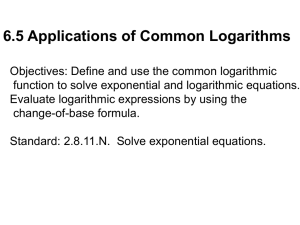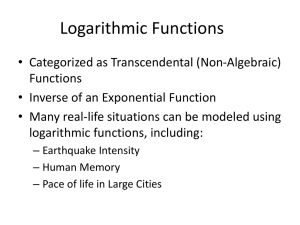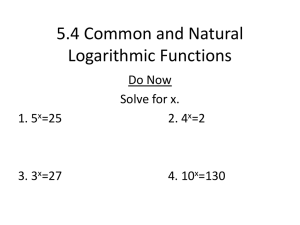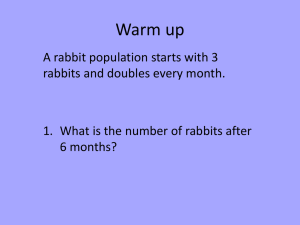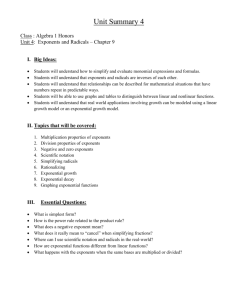Chapter 5 notes
advertisement
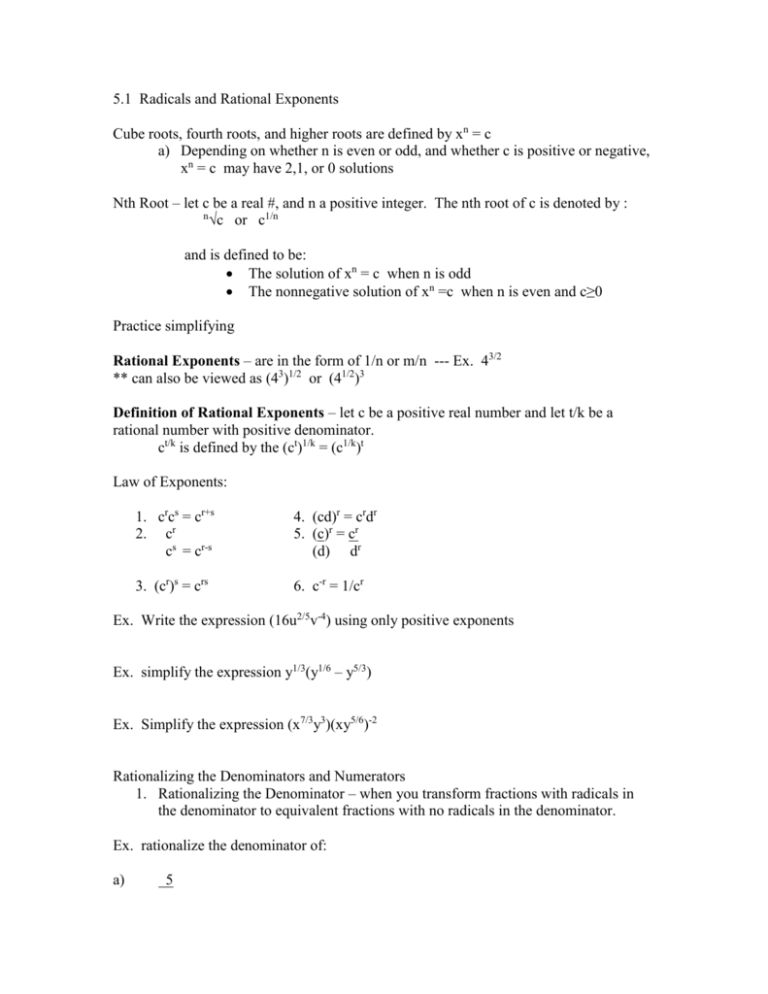
5.1 Radicals and Rational Exponents Cube roots, fourth roots, and higher roots are defined by xn = c a) Depending on whether n is even or odd, and whether c is positive or negative, xn = c may have 2,1, or 0 solutions Nth Root – let c be a real #, and n a positive integer. The nth root of c is denoted by : n √c or c1/n and is defined to be: The solution of xn = c when n is odd The nonnegative solution of xn =c when n is even and c≥0 Practice simplifying Rational Exponents – are in the form of 1/n or m/n --- Ex. 43/2 ** can also be viewed as (43)1/2 or (41/2)3 Definition of Rational Exponents – let c be a positive real number and let t/k be a rational number with positive denominator. ct/k is defined by the (ct)1/k = (c1/k)t Law of Exponents: 1. crcs = cr+s 2. cr cs = cr-s 4. (cd)r = crdr 5. (c)r = cr (d) dr 3. (cr)s = crs 6. c-r = 1/cr Ex. Write the expression (16u2/5v-4) using only positive exponents Ex. simplify the expression y1/3(y1/6 – y5/3) Ex. Simplify the expression (x7/3y3)(xy5/6)-2 Rationalizing the Denominators and Numerators 1. Rationalizing the Denominator – when you transform fractions with radicals in the denominator to equivalent fractions with no radicals in the denominator. Ex. rationalize the denominator of: a) 5 √6 b) 3 4 + √5 Rationalize the numerator of: a) √2t + h - √2t h Irrational Exponents 5.2 Exponential Functions Exponential function Rule: Ex. f(x) = 10x f(x) = ax where a = base and a≠1 f(x) = ⅔x **shape of graph depends on the size of a If a>1 * graph above x axis * y intercept = 1 * f(x) is increasing * f(x) approaches the negative x axis as x approaches -∞ If 0 < a <1 * graph above x axis * y intercept = 1 * f(x) is decreasing * f(x) approaches the positive x axis as x approaches ∞ If a=0 or a=1 then f(x) = ax is a constant function – not exponential (creates horizontal line) 0x = 0 and 1x = 1 If a < 0 not defined b/c not well defined --- Look at graphing extension a/b Graph facts: #1. when a>1 – steeper graphs correspond to greater a values Closer to y axis #2. when a>1 – the graph falls toward the x-axis more quickly for bigger values of a #3. when 0<a<1 – steeper graphs correspond to smaller values of a A. Translations – we can execute on exponential functions If f(x) = 2x what happens to g(x) = 2x – 4 and h(x) = 2x+2 + 3 B. Horizontal Stretch – by a factor of 1/b --(pulling away from y axis) f(x) = 4x describe what is happening to the following: 1) g(x) = 4.5x (1/.5) = 2 2) h(x) = 4.4x 3) k(x) = 4-x 4) p(x) = 4-.2x C. Vertical Stretch – will be multiplied by constant b ** if constant is (-) then graph is reflected across x- axis, (still pulling away from x axis) otherwise, if exponent is (-), then it is reflected across y axis (pulled away from x axis) f(x) = 2-.8x describe what is happening to the following 1) q(x) = 3∙2-.8x 2) r(x) = (-5)2-.8x Exponential Growth – occurs when a function is increasing at an explosive rate Ex. If you invest $10,000 in a CD with an interest rate of 4% per year and the value of your CD is given by the function f(x) = 10,000(1.04)x where x is measured in years: a) How much is the CD worth in 5 years b) When will the CD be worth $18,000 Ex. (population growth) The projected population of Tokyo, Japan in millions from 2000 to 2015 can be approximated by g(x) = 26.4(1.0019)x where x = 0 corresponds to year 2000. a) Estimate the population of Tokyo in 2015 b) If the population continues to grow at this same rate after 2015, in what year will the population reach 30 million? Exponential Decay – when a function is decreasing at an explosive rate Ex. (Radioactive decay) – Geologists and Archeologists use carbon 14 to determine the age of organic substances such as bones, or small plants and animals found embedded in rocks. The amount from 1 kg of c-14 that remains after x years can be approximated by the function m(x)=.99988x. Estimate the amount of c-14 remaining after 2000 years. Natural Exponential Function (e) – is an irrational number, that is used to describe things that occur in the physical universe. e= 2.71828…. ex graph = has the same shape as y = 2x, and y=3x but climbs more steeply than y = 2x and less steeply than y = 3x Ex. the population of LA, California since 1970 in millions can be modeled by P(t) = 2.7831e.0096t where t represents time in years a) Estimate the population in 2010 b) Estimate when the population will reach 5 million 5.3 Applications of Exponential Functions Compound Interest – when interest is paid on a balance that includes interest accumulated from the previous time periods A = P(1 + r)t P = dollars invested t = time period r= interest rate (in %) A = amount after t periods Ex. If you invest $9000 at 4% interest compounded annually, how much is the account at the end of 5 years. A = 9000(1+.04)5 = Ex. Determine the amount that a $5000 investment over 10 years at an annual interest rate of 4.8% is worth for each period. a) Annually b) Quarterly c) Monthly d) Daily Ex. If $7000 is invested at 5% annual interest, compounded monthly, when will the investment be worth $8500 (hint: solving for t) Continuous compounding = when the number of compounding periods increases without bound. A = Pert where P = dollars invested r = annual interest rate A = amount after t years Ex. If you invest $3500 at 3% annual interest compounded continuously, how much is in the account at the end of 4 years? Exponential Growth – a function in form of f(x) = Pax where f(x) is the quantity at time x, P = initial quantity when x = 0, a>1 is the factor by which the quantity changes when x increases by 1. ** If f(x) is growing at a rate r per time period than a = 1+r and f(x) = Pax = P(1+r)x Ex. The population of Tokyo in the year 2000 was @ 26.4 million and is projected to increase at a rate of ≈.19% per year. Write the f(x) that gives the population of Tokyo in year x, where x = 0 corresponds to 2000 Ex. A newly formed lake is stocked with 900 fish. After 6 months, biologists estimate there are 1710 fish in the lake. Assuming the fish populations grows exponentially how many fish will there be after 24 months? F(x) = 900ax ---- 900a6=1710 -- a6 = 1.9 = 6√1.9 = 1.91/6 F(24) = 900(1.91/6)24 = Exponential Decay – a quantity decreases by a fixed factor in form of f(x) = Pax where f(x) is quantity at time x, P = initial quantity when x = 0 and 0<a<1 is the factor by which the quantity changes when x increases by 1 **If the quantity f(x) is decaying at a rate r, per time period then a = 1- r and F(x) = Pax = P(1 – r)x Ex. Each day 15% of the chlorine in a swimming pool evaporates. After how many days will 60% of the chlorine have evaporated? Radioactive Decay – the amount of a radioactive substance that occurs is given by the function: f(x) = P(.5)x/h where P = initial amount ** x=0 corresponds to the time when the radioactive decay began, and h is the half-life of the substance. Ex. The isotope iodine 131 is used to treat some types of thyroid disease. Iodine 131 decays exponentially with a half-life of 8.02 days. If a quantity of iodine 131 is administered to a patient, how long will it take for 99% of it to decay? 5.4 Common and natural Logarithmic Functions Logarithms – play an important role in science and engineering (this is for those of you Whose 1st thought is – when will I ever use this?) Common Logs Ex. – look at the graph of f(x) = 10x -- it is increasing and is one to one ** the graph of the inverse of this function would be a reflection across the line y=x **inverse of an exponential function = a logarithmic function For Base 10 system: Exponential Form: ax = y (a will always be 10 for base 10 system) Logarithmic Form: log y = x Ex. log 100 write in exponential form --- 10x = 100 a) log 1000 b) log 10,000 c) log 3√10 d) log (-7) Using a calculator a) log x = 5 b) 10x = 52 Natural Logarithms - are inverses of the natural exponential function y = ex and denoted by ln x *so ln y = x if and only if ex = y Ex. a) ln 14 = 2.6391 and e2.6391 = 14 b) ln 1.3 c) ln 203 d) ln (-12) – undefined b/c no exponent of e will produce -5 Special Cases: #1. ln e = 1 and e1 = e #2. ln 1 = 0 and e0 = 1 Ex. ln x = 2 then e2 = x so x = 7.3891 a) ex = 8 then Know the chart on page 359: Exponential Ex. f(x)=10x, f(x)= ex Logarithmic g(x)=log x, g(x) = ln x Domain: all real #’s all positive real #’s Range: *all positive real #’s *f(x) increases as x increases *f(x) approaches the x axis as x decreases *all real #’s *g(x) increases as x increases *g(x) approaches the y-axis as x approaches 0 Reference Pts. f(x) = 10x (-1,1/10), (0,1), (1,10) g(x) = log x (1/10,-1),(1,0),(10,1) F(x) = ex (-1, 1/e),(0,1)(1,e) g(x) = ln x (1/e,-1), (1,0),(e,1) Transforming Logarithmic Functions – follow all the same rules: translations, stretches, compressions, reflections, etc. 5.5 Properties and Laws of Logs Properties of Logarithms – are only defined for positive real #’s In base 10 -- log and 10x are reciprocals #1. log v and ln v are defined only when v > 0 #2. log 1 = 0 and ln 1 = 0 #3. log 10k = k #4. ln ek = k for every real #k for every real #k #5. 10log v = v for every v>0 #6. eln v = v for every v>0 Ex. use the basic properties of logarithms to solve the equation log(x-3) = 1 Log x-3 = 1 ---- take the reciprocals to get rid of the log so a) x – 3 = 10 ---- solve for x b) x = 7 Ex. log (x-3) = 2 Ex. ln(x+1) = 2 Laws of Logs: #1. Product Law * for all v, w >0 then log (vw) = log v + log w then ln(vw) = ln v + ln w Ex. given log 3 = .4771 and log 4 = .6021 Find log 12 #2. Quotient Law * for all v, w>0 then log (v/w) = log v – log w then ln (v/w) = ln v – ln w Ex. given that log 40 = 1.6021 and log 8 = .9031 find: a) Log 5 Ex. Given that ln 32 = 3.4657 and ln 8 = 2.0794 find: a) Ln 4 #3. Power Law of Logarithms – for all k and v>0 vk a) log = klog v b) ln vk = kln v Ex. Given that log 25 = 1.3979 find 4√25 Ex. Given that ln 22 = 3.0910 find ln √22 Simplifying Logarithmic Expressions: - basically means going backwards 1. Write log 8x + 3logx – log2x² as a single logarithm 5.5A Logarithmic functions to other Bases --Inverse function g = logarithmic function to the base b -- Value of g(x) at the number x is denoted by logbx and is called the logarithm to the base b. So: logbv = u if and only if bu = v Ex. Log Statement Log381 = 4 Log464 = 3 Log1255 = ⅓ Equivalent exponential statement 34 = 81 4³ = 64 125⅓ = 5 8-⅔ = ¼ Log8¼ = -⅔ Find: a) b) c) d) e) f) g) log327 log½32 log4(-64) log6x = 2 log41 = x log1/5(-10)=x log77 = x Basic Properties of Logarithms to other bases 1. logarithms are only defined for + real #’s **So: logbv is defined only when v>0 2. logb1 = 0 3. logbbk = k for every real #k 4. blogbv = v for every v>0 -- ex. log3104 is the exponent to which 3 must be raised to produce 104 -- 3log3104=104 Ex. Solve the equation log5(x+2) = 2 5log5(x+2) = 5² x+2 = 25 x = 23 Laws of Logs to other Bases 1. Product law - logb(vw) = logbv + logbw 2. Quotient law - logb(v/w) = logbv - logbw 3. Power law – logbvk = klogbv Ex. given that log53 = .6826 log54 = .8614 and log56 = 1.1133 a)log518 b) log5.75 c) log554 Simplify and write as a single logarithm a) log8(x+5) + log8z – log8(x² + 10x +25) b) 2 + log3(x/9) Change of Base Formula: - For every positive #, v log v logbv = log b and ln v logbv= ln b Ex. Evaluate log57 Graphing Logarithm Functions to Other Bases: Exponential F(x) F(x) = bx Logarithmic f(x) g(x) = logbx Domain All real #’s all positive real #’s Range *all positive real #’s *f(x) increases as x increases *f(x) approaches x-axis as x decreases *all real #’s *g(x) increases as x increases *g(x) approaches the y axis as x approaches 0 Reference Pts: (-1, 1/b) (0,1) (1,b) (1/b,-1), (1,0), (b,1) Graphing Transforming Logarithmic f(x): Ex. describe the transformation from g(x) = log3x to h(x) = log3(x-4) + 1 5.6 Solving Exponential and Logarithmic Equations – Algebraically ** If u = v, then bu = bv for all real #’s b>0 ** If u = v, then logbu = logbv for al real #’s b>0 b/c exponential and logarithmic functions are 1 to 1 functions, the converse is also true: ** if bu= bv then u = v ** if logbu = logbv then u = v Exponential Equations- easiest equations to solve are those in which both sides are powers of the same base. #1. Powers of the Same Base Solve: 9x = 3x-1 #2. Powers of Different Bases – use inverse to solve Solve: 6x = 3 #3. Powers of Different Bases – use inverses to solve Solve: 42x – 1 = 51- x ** When multiplying each equation by same expression, extraneous solutions may be introduced. Ex. Solve the equation ex – 5e-x = -6 a) first multiply by ex to eliminate exponents ex(ex-5e-x) = ex(-6) = e2x – 5 = -6ex = (ex)2 + 6ex – 5 = 0 b) now let u = ex = u² + 6u – 5 = 0 c) use quad. Formula to solve a =1 b= 6 c =-5 u = -3±√14 --- e must be positive so = -3+√14 d) now finish ex = -3 +√14 (take inverse of each side) (ln) ex = (ln)-3+√14 x = ln -3+√14 ln e x = -.2989 Logarithmic/Natural Logarithmic Equations – use properties to solve Ex. Solve ln(4x -1) + ln(x+2) = 2 ln x Equations with Constant and Logarithmic Terms: Ex. ln(2x +1)= 8 – ln(2x+1) Ex. log(x+2) = 1-log(x-1) Applications with Exponential and Logarithmic Equations: **Equation for Radioactive Decay = f(x)= (.5)x/h Where P = initial amount of substance x = time when radioactive decay began h= the half-life of the substance Ex. It is determined that a mummy has lost 32% of its original carbon 14. When did the person die? (half life of carbon 14 is 5730 years) Compound Interest. Ex. If $8000 is to be invested at 6% per year compounded monthly, in how many years will the investment be worth $22,520? (A=p(1+r)t) Population Growth Ex. S(t) = Pert – population of a certain species of rabbit increases exponentially according to formula, where P is the initial population, and r is the continuous growth rate. At the beginning of a 12 month study, there were 50 rabbits, and at the end of the study there were 164 rabbits. a) Write the f(x) for the population b) When will it reach 1000




